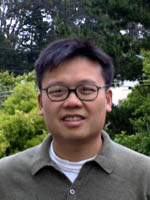
Website: http://limlab.ucsf.edu Email: wendell.lim / ucsf, edu
600 16th Street, MC 2240Genentech Hall, Room N412ESan Francisco, CA 94158-2240
Phone: 415 502-8080
Administrative AssistantNoleine Blizzard415 514-4137noleine.blizzard / ucsf, edu
The Molecular Logic of Cellular Signaling Systems
Signal transduction
Protein-protein recognition
Protein switches and networks
Signaling protein and network evolution
Systems biology
Biological computation
Synthetic biology
Livings cells process vast amounts of environmental information to generate sophisticated responses such as movement, growth, and differentiation. Such decisions are made by complex networks of signal transduction proteins. One of the most challenging problems in modern biology is understanding how these networks of proteins act to carry out these remarkable behaviors.
A striking commonality among eukaryotic signaling molecules is that they are composed of modular domains. Some domains carry our catalytic functions, but most mediate specific protein-protein interactions. This modular organization of signaling proteins suggests that a common toolkit of components has been used in a combinatorial fashion to evolve the complex signaling proteins and pathways we see today. We are therefore interested in understanding the logic by which simple protein components can be used to build complex information processing systems. We would like to answer this question at several hierarchical levels:
We are probing these questions by studying kinase and GTPase pathways involved in controlling cell movement and stress responses in yeast and mammalian cells. To achieve these goals we take a highly interdisciplinary approach that incorporates diverse techniques including: Mechanistic biochemistry Biophysical methods X-ray crystallography, NMR Molecular biology Cell biology Yeast genetics Protein, pathway engineering